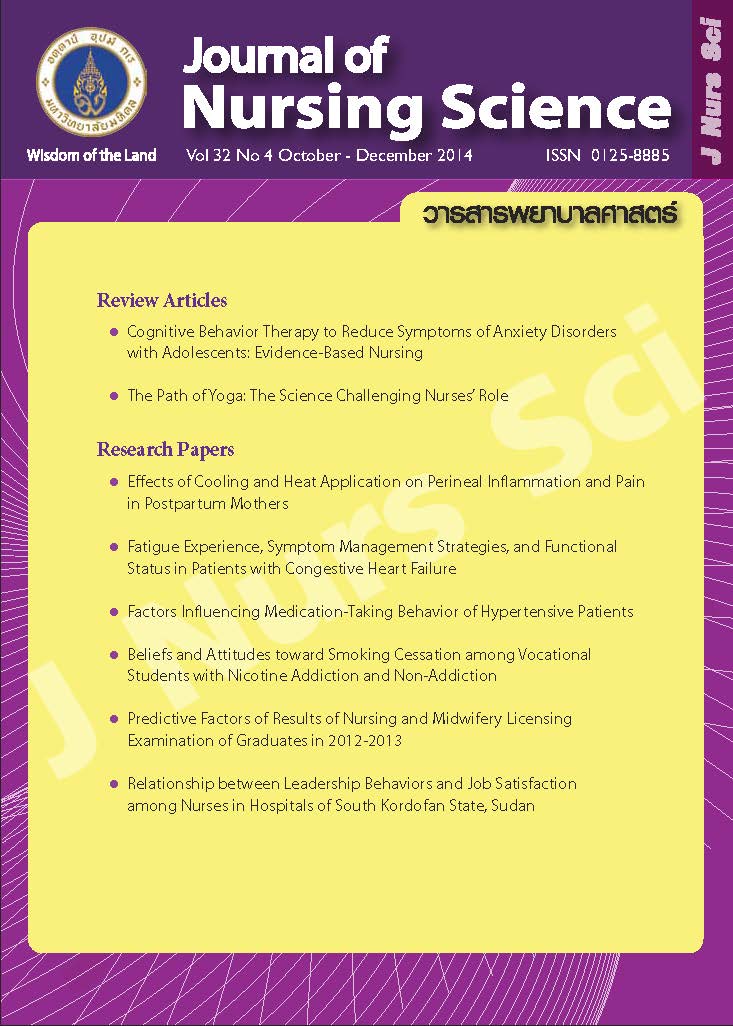Effects of Cooling and Heat Application on Perineal Inflammation and Pain in Postpartum Mothers
Main Article Content
Abstract
Purpose: To study the effects of cooling and heat application on perineal inflammation and pain in postpartum mothers.
Design: Quasi-experimental research.
Methods: The subjects were 60 primiparous postpartum mothers at Thammasat University Hospital who gave birth vaginally and received episiotomy with 2nd degree perineal tear. The subjects were divided into two groups with 30 cases each. The experimental group received 1) the cooling gel pack pads for 20 minutes twice, the first immediately after perineorrhaphy and then six hours apart, 2) the hot sitz bath for 20 minutes twice, the first after 24 hours postpartum and then six hours apart. The control group received routine care. Perineal pain was assessed by the numeric pain rating scale and perineal inflammation was assessed by the REEDA Scale
three times: immediately after perineorrhaphy, at 24 hours and 48 hours postpartum. The data were analyzed by descriptive statistics, independent t-test and analysis of covariance.
Main findings: The subjects in the experimental group had mean scores of perineal inflammation at 24 hours and 48 hours postpartum lower than those in the control group with statistical significance (F = 10.64, p < .001 and F = 8.14, p < .001 respectively). However, both groups did not have different mean perineal pain scores at 24 hours and 48 hours postpartum (F = 1.60, p > .05 and F = 1.81, p > .05, respectively).
Conclusion and recommendations: The findings revealed that using cooling and heat application during the first 48 hours postpartum could effectively reduce perineal inflammation in postpartum mothers. This intervention should be used in all postpartum mothers who undergo episiotomy.
Keywords: cooling, heat, perineal inflammation, perineal pain, postpartum mothers
ผลของการใช้ความเย็นและความร้อนต่อการอักเสบและความเจ็บปวดของแผลฝีเย็บในมารดาหลังคลอด
บทคัดย่อ
วัตถุประสงค์: เพื่อศึกษาผลของการใช้ความเย็นและความร้อนต่อการอักเสบและความเจ็บปวดแผลฝีเย็บในมารดาหลังคลอด
รูปแบบการวิจัย: การวิจัยแบบกึ่งทดลอง
วิธีดำเนินการวิจัย : กลุ่มตัวอย่างเป็นมารดาหลังคลอดครรภ์แรกจำนวน 60 ราย ที่มารับบริการในโรงพยาบาลธรรมศาสตร์เฉลิมพระเกียรติ มีการคลอดปกติทางช่องคลอดและได้รับการตัดฝีเย็บ โดยมีแผลฉีกขาดระดับ 2 แบ่งเป็น 2 กลุ่มๆ ละ 30 รายเท่ากัน กลุ่มทดลองได้รับการประคบแผลฝีเย็บด้วยแผ่นเจลชนิดเย็น 2 ครั้ง นานครั้งละ 20 นาที ห่างกัน 6 ชั่วโมง เริ่มประคบทันทีหลังเย็บแผลเสร็จ และแช่แผลฝีเย็บในน้ำอุ่น 2 ครั้ง นานครั้งละ 20 นาที ห่างกัน 6 ชั่วโมง ภายหลัง 24 ชั่วโมงแรกหลังคลอด และกลุ่มควบคุมได้รับการพยาบาลตามปกติ ประเมินความเจ็บปวดแผลฝีเย็บโดยใช้แบบประเมินระดับความเจ็บปวดแผลฝีเย็บ และประเมินการอักเสบของแผลฝีเย็บโดยใช้แบบประเมินลักษณะแผลฝีเย็บหลังคลอด (REEDA scale) รวม 3 ครั้ง ได้แก่ หลังเย็บแผลเสร็จทันทีที่ 24 ชั่วโมง และที่ 48 ชั่วโมงหลังคลอด วิเคราะห์ข้อมูลโดยใช้สถิติเชิงพรรณนา สถิติทดสอบค่าที และการวิเคราะห์ความแปรปรวนรวม
ผลการวิจัย: กลุ่มทดลองมีคะแนนเฉลี่ยการอักเสบของแผลฝีเย็บที่ 24 ชั่วโมงและที่ 48 ชั่วโมงหลังคลอดต่ำกว่ากลุ่มควบคุมอย่างมีนัยสำคัญทางสถิติ (F = 10.64, p < .001 และ F = 8.14, p < .001 ตามลำดับ) แต่ทั้งสองกลุ่มมีคะแนนเฉลี่ยความเจ็บปวดแผลฝีเย็บที่ 24 ชั่วโมงและที่ 48 ชั่วโมงหลังคลอดไม่แตกต่างกัน (F = 1.60, p > .05 และ F = 1.81, p > .05 ตามลำดับ)
สรุปและข้อเสนอแนะ: ผลการศึกษาแสดงให้เห็นว่าการใช้ความเย็นและความร้อนในระยะ 48 ชั่วโมงแรกหลังคลอด เป็นวิธีหนึ่งที่สามารถลดการอักเสบของแผลฝีเย็บในมารดาหลังคลอดได้อย่างมีประสิทธิภาพ และควรนำมาใช้ในการดูแลมารดาหลังคลอดที่ได้รับการตัดฝีเย็บทุกราย
คำสำคัญ: ความเย็น ความร้อน การอักเสบของแผลฝีเย็บ ความเจ็บปวดแผลฝีเย็บ มารดาหลังคลอด
Article Details
Copyright Notice: Nursing Science Journal of Thailand has exclusive rights to publish and distribute the manuscript and all contents therein. Without the journal’s permission, the dissemination of the manuscript in another journal or online, and the reproduction of the manuscript for non-educational purpose are prohibited.

Disclaimer: The opinion expressed and figures provided in this journal, NSJT, are the sole responsibility of the authors. The editorial board bears no responsibility in this regard.


